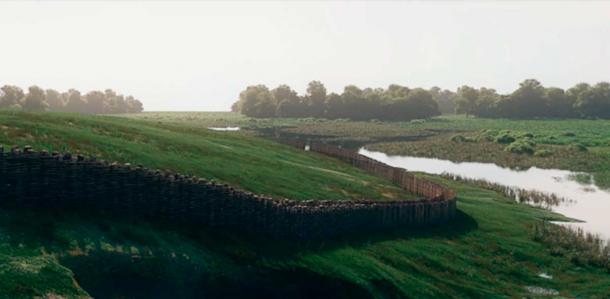
6,300-Year-Old Settlement Was Home to Earliest Megalithic Builders
Archaeologists in France have found evidence of a 6,300-year-old fortified compound and residential site belonging to Europe’s first megalithic builders! These builders constructed impressive megalithic monuments during the Neolithic period, including barrows and dolmens, though their identity and whereabouts have remained a mystery, until now.
The people who built these structures have long been admired for their engineering prowess, and now a team of researchers have identified the elusive Le Peu enclosure in southwestern France as where some of them lived. The site was first identified during an aerial survey in 2011, and at least three buildings, 13 feet long (3.9 meters) were found constructed on the top of a hill.
The results of their research have been published in the latest edition of the journal Antiquity, with a digital reconstruction of the site where these megalithic workers lived, just a few kilometers from their work site. Together, they have pieced together details of the settlement, the life lived there, and the potential cause of the site’s destruction.
“We know [of] a lot of megaliths… [They are] very famous and so many people are interested in [them], but we don’t know where the builders lived,” Dr. Vincent Ard from the French National Centre for Scientific Research, who also led the study, told Inverse.
- Neolithic Revolution Spurred Mental and Physical Growth of Europeans
- Stonehenge Builders Were Immigrants From What is Now Turkey

3D reconstruction of the enclosure of Le Peu and its environment from archaeological data. (© Archeovision Production 2018/ Antiquity Publications Ltd)
The Settlement at Le Peu
The Le Peu enclosure is a remarkable find, revealing a palisade encircling several timber buildings built during the fifth millennium BC. It is the oldest wooden structure in the region and the first residential site contemporary with the Neolithic monument makers. The site consists of at least three homes clustered together near the top of a small hill enclosed by the palisade.
Le Peu was built on a limestone hill flanked by valleys, and the archaeologists suspect that the proximity of the site to Tusson, a prehistoric cemetery consisting of five barrows, is not a coincidence. At 139 meters (456 feet) long and featuring masterful stonework, the Tusson tombs are among the more impressive features of their kind in Europe, with builders recycling stones from older tombs.
Enclosures and Burial Practices
These tombs have not been excavated yet, but Ard suspects that they may provide additional insights into the people who built the wooden structures at Le Peu. The researchers believe that the inhabitants of Le Peu may have built the site's five long mounds, visible from their hilltop home. To test this theory, the archaeologists carried out radiocarbon dating that revealed these monuments are contemporary with Le Peu, further suggesting the two sites are linked.
The people of Le Peu invested a lot of time and effort in protecting the living, as analysis of the paleosol (ancient soil) recovered from the site revealed it was located on a promontory bordered by a marsh. These natural defenses were enhanced by a ditch palisade wall, which extended around the site. The entrance had particularly heavy defenses, guarded by two monumental structures that appear to have been later additions, requiring part of the defensive ditch to be filled in, write the authors of the study.
- Evidence of Twisted Human Brains Found in Neolithic Settlements
- Neolithic Drum Sculpture Declared ‘Most Important Piece of Prehistoric Art’

A digital reconstruction of the wooden palisade around the enclosure. (© Archeovision Production 2018/ Antiquity Publications Ltd)
The houses were surrounded by a double palisade and a ditch, which indicate that they were built for defensive purposes. It is believed that hostile forces would have had to overcome these three obstacles in order to gain entry to the houses.
Interestingly, Le Peu is not the only site in this region of France where such compounds have been discovered. In fact, around 300 similar compounds have been unearthed, all dating back to the Late Neolithic period. This suggests that the people who lived in this area during this time period were particularly concerned with defense, perhaps due to frequent attacks from hostile neighboring groups.
Breaching the Defensive Barrier: A Brutal End?
According to Dr. Ard, "the site reveals the existence of unique monumental architectures, probably defensive. This demonstrates a rise in Neolithic social tensions”. However, these impressive defenses may have proved insufficient as all the buildings at Le Peu appear to have been burnt down around 4400 BC – most probably conflict being the culprit. This could have been arson from an enemy from outside, or a purposeful destruction of the site, reports The Express.
“It's evidence of probable conflict, but [it’s] just evidence by the observation of the architecture,” Ard says. “We don't have any direct traces of conflict, but it's very, very probable.” This is in addition to no punctured skulls or cut-up bones being unearthed from Le Peu. In fact, the limited human remains at the site show no evidence of damage from weapons. It is important to note that violence during the Neolithic period was very common and has been witnessed at many sites in Europe.
The discovery of Le Peu is significant because it sheds new light on the lives of people only known from their monuments to the dead. “…perhaps the wooden structures can be seen as an alternative form of monumentalism for the world of the living” adds Dr. Ard. It shows how their residential sites had a monumental scale, never before seen in prehistoric Atlantic society.
Three more enclosures like Le Peu have been located within a 2-kilometer (1.2 mile) radius of the site, occupied after Le Peu was abandoned. This only leaves us with more questions than answers. Were they a refuge for those running for their lives? We also don’t know how the builders at Le Peu commuted to their work sites. Dr. Ard and the team hope that further research at Le Peu will continue to uncover more insights into the lives and social structures of these early megalithic builders.
Top image: 3D reconstructions of the enclosure of Le Peu and its environment from archaeological data. Source: © Archeovision Production 2018/ Antiquity Publications Ltd
By Sahir Pandey
References
Ard, V. et al. 2023. The emergence of monumental architecture in Atlantic Europe: a fortified fifth-millennium BC enclosure in western France. Antiquity, 97 (391). Available at: https://doi.org/10.15184/aqy.2022.169.
Randall, I. 2023. Archaeologists find home of Europe’s first megalithic monument makers. Available at: https://www.express.co.uk/news/science/1737623/home-europe-first-megalithic-monument-makes-discovered-le-peu.
Schuster, R. 2023. Archaeologists Find Homes of Europe’s First Monument Builders, and They’re Fortified. Available at: https://www.haaretz.com/archaeology/2023-02-21/ty-article/archaeologists-find-homes-of-europes-first-monument-builders-and-theyre-fortified/00000186-6dc6-dc51-a197-7fce6ec20000.
Walter, J. 2023. Centuries Before Stonehenge, This Settlement Housed the First European Stone Monument Builders. Available at: https://www.inverse.com/science/megalith-builders.















